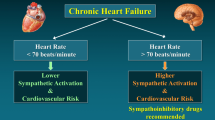Summary
To evaluate the effect of converting enzyme inhibition induced by enalapril on parasympathetic activity, we studied ten essential hypertensive patients, age range 38–58 years, WHO I–II. Parasympathetic evaluation was obtained by measuring the variation of heart period (VHP) during at least 1 minute of steady-state, regular respiration. VHP was derived from the difference between the mean of all maximum and the mean of all minimum heart periods. The higher the VHP, the higher the parasympathetic control of heart rate and vice versa. VHP was measured supine and with tilting (30°, 60°, 85°). Blood pressure was reduced after 1 month of enalapril treatment, while the heart rate did not change. VHP increased at the end of enalapril treatment compared with placebo: in the supine position it increased from 36±3.2 ms to 44±3.5 ms, p<0.01. VHP was also increased by enalapril at 30° (p<0.05) and 60° (p<0.05), while no difference was observed at 85° between placebo and enalapril. A positive correlation was found between supine enalapril changes of VHP and those of systolic and diastolic BP. In conclusion, enalapril seems to increase parasympathetic cardiovascular control in essential hypertensive patients. This result might explain the lack of increase in heart rate that would be expected as a result of the vasodilating effect of enalapril.
Similar content being viewed by others
References
Campbell CB, Sturani A, Reid JL. Evidence of parasympathetic activity of the angiotensin converting enzyme inhibitor, captopril, in normotensive man.Clin Sci 1985; 68:49–56.
Reid JL, Millar JA, Campbell BC. Enalapril and autonomic reflexes and exercise performance.J Hypertens 1983;1 (Suppl 1):129–134.
Vidt D, Bravo EL, Fouad TM. Captopril.N Engl J Med 1982;306:214–219.
Julius S, Pascual AV, London R. Role of parasympathetic inhibition in the hyperkinetic type of borderline hypertension.Circulation 1971;44:413–418.
Alicandri C, Fariello R, Boni E, et al. Autonomic nervous control of heart rate in essential hypertension.J Hypertens 1985;3 (Suppl 3):S117–S119.
Bussolati C, Pissarello M, Sardini E, et al. A microprocessor system for automatic analysis of arterial pressure and ECG signals. In: Del Palu C, Passina AC, eds.Proceedings of the Fifth International Symposium on Ambulatory Monitoring. Padova: CLEUP, 1986:67–74.
Katona PG, Poitras JW, Barnett GO, et al. Cardiac vagal efferent activity and heart period in the carotid sinus reflex.Am J Physiol 1970;218:1030–1037.
Katona PG, Jih F. Respiratory sinus arrhythmia: Noninvasive measure of parasympathetic cardiac control.J Appl Physiol 1975;39(5):801–805.
Fouad FM, Tarazi RC, Ferrario CM, et al. Assessment of parasympathetic control of heart rate by noninvasive method.Am J Physiol 1984;246:H838–H842.
Sturani A, Chiarini C, Esposti E, et al. Parasympathomimetic effects of captopril.N Engl J Med 1982;307:59–60.
Bravo EL, Tarazi RC. Therapeutic results of interference at different points of the renin angiotensin cascade. In:Proceedings of the First Asian Pacific Congress of Nephrology. 1979:231–239.
Wallace JM, Keim HJ, Case DB, et al. Reduction of cardiac output with angiotensin blockade in hypertension (abstract).Clin Res 1976;24:244A.
Fouad FM, Ceimo JMK, Tarazi RC, et al. Contrast and similarities of acute hemodynamic responses to specific antagonism of angiotensin II (Sar1, Thr8) AII and to inhibition of converting enzyme (captopril).Circulation 1980;61:163–169.
Muiesan G, Alicandri C, Agabiti-Rosei E, et al Angiotensin-converting enzyme inhibition, catecholamines and hemodynamics in essential hypertension.Am J Cardiol 1982; 49:1420–1424.
Morganti A, Pickering TG, Lopez-Ovejero J, et al. Humoral effects of the oral converting-enzyme inhibitor SQ 14, 225 in hypertensive patients in supine and tilted position.Clin Sci 1979;57 (Suppl 5):149s–152s.
Bravo EL, Tarazi RC. Converting enzyme inhibition with an orally active compound in hypertensive man.Hypertension 1979;1:39–46.
Author information
Authors and Affiliations
Rights and permissions
About this article
Cite this article
Boni, E., Alicandri, C., Fariello, R. et al. Effect of enalapril on parasympathetic activity. Cardiovasc Drug Ther 4, 265–268 (1990). https://doi.org/10.1007/BF01857643
Issue Date:
DOI: https://doi.org/10.1007/BF01857643




